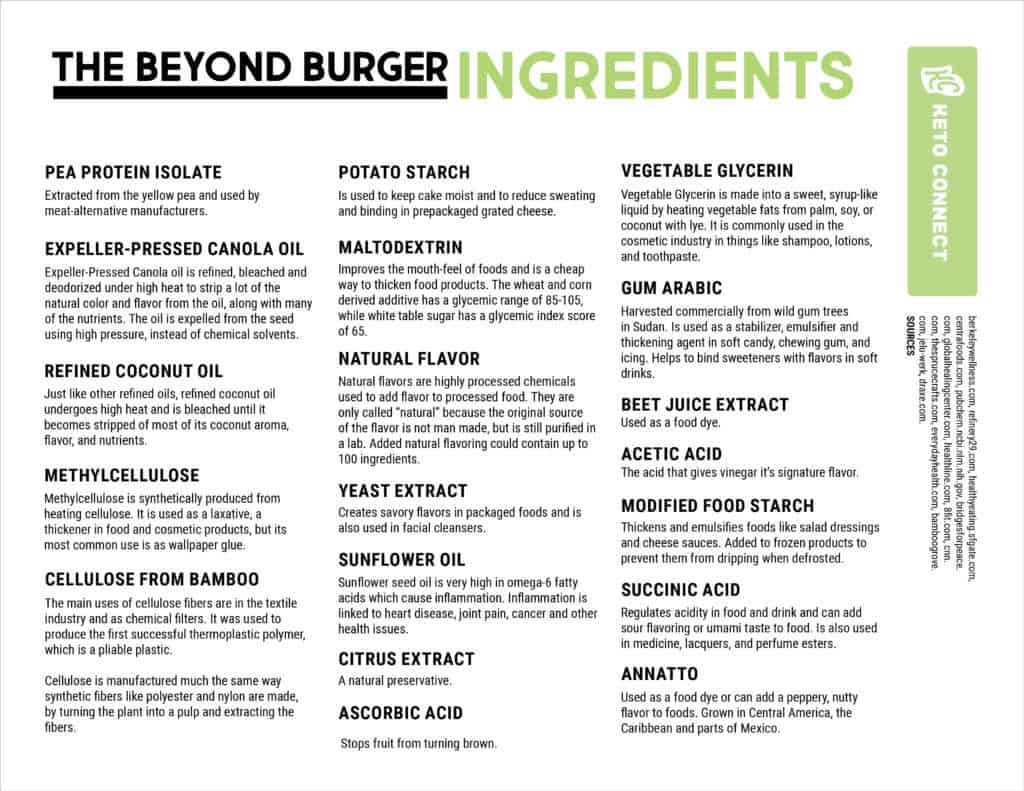
BEYOND MEAT INGREDIENTS FREE
Some of the main benefits of consuming plant-based meat alternatives are subjective in that many people choose to consume them for a variety of personal reasons.įor example, I eat plant-based meat alternatives because they are more aligned with my personal ethics than eating meat.Įating plants means that I’m not supporting industrialized animal agriculture or its effects on animal welfare, the environment, and public health ( 10, 11).Īdditionally, certain plant-based meats are free from nutrients that some people may want to limit for heart health, such as saturated fat and sodium - though the amounts depend on the specific product ( 12). Some of the most common are seitan, jackfruit, soy foods, and premade products that mimic traditional meats, such as those from the brands Impossible Foods and Beyond Meat.īenefits of plant-based meat alternatives There are more plant-based meat alternatives today than ever before. Some of the more processed plant-based meat alternatives, such as premade veggie burgers, use soy protein in their recipes. Tempeh works well sliced into thin strips and added to stir-fry or crumbled and used in stews, chilis, tacos, or sloppy joes. This is a fermented soybean product sold in long blocks. You can use it in stir-fry or salads, slice it and add it to sandwiches, or crumble it and cook it with vegetables (similar to the way some folks might use scrambled eggs). A spongy cake made from soybeans and water, tofu can be pressed, cubed, and cooked. You can also cook them and eat them as a snack. Also called edamame, soybeans are a great addition to stir-fry. Soy-based foods include the following popular choices: Soy-based foods tend to have a mild flavor and versatile texture that make them ideal for use in many traditionally meat-based dishes. Soy is a legume and one of the original plant-based meat alternatives. However, it does offer some fiber and a small number of micronutrients, such as iron, potassium, and calcium ( 7). Jackfruit is low in calories and doesn’t have much protein or fat compared to other plant-based meat alternatives. For instance, I like to put plain jackfruit in the slow cooker with barbecue sauce and onions to make sandwiches. It has a thick, green, bumpy rind and soft, stringy inner flesh with edible seeds ( 6).īecause of its consistency and mild flavor, jackfruit flesh is often used in place of meat dishes such as pulled pork. Jackfruit is a large tropical fruit that grows in Asia, Africa, and some areas in South America. For instance, one patty offers 50% of the Daily Value for zinc, 130% for vitamin B12, and 25% for iron ( 5). The Impossible Burger offers an array of micronutrients. While it’s normally derived from animal products, the heme iron used for Impossible Burgers is derived from the root nodules of soybean plants and made through the fermentation of genetically engineered yeast ( 4). They get their meat-like flavor from heme iron. Instead of pea protein, Impossible Burgers use potato and soy proteins. Impossible Foods, the brand behind these burgers, also makes meatless sausage, chicken-style nuggets, and pork alternatives using plant ingredients.

Impossible Burgers are a similar concept to the Beyond Burger. One patty provides 100% of the Daily Value for vitamin B12, 40% for zinc, and 20% for iron ( 3). It also contains refined coconut oil, rice protein, cocoa butter, and dried yeast.īeyond Burgers are free from soy and gluten and are naturally colored using beet juice. The primary ingredient in a Beyond Burger is pea protein. While it was initially recognized for its debut vegan burger, called the Beyond Burger, this brand now also makes plant-based ground meat, sausage, meatballs, and chicken. Beyond Meat productsīeyond Meat is a popular brand of plant-based meat products. However, because it’s made with gluten, seitan isn’t appropriate for people who have celiac disease or non-celiac gluten sensitivity. All you have to do is combine ingredients in a mixer, create a dough, and then boil slices of the dough to cook it. You can also make seitan at home using vital wheat gluten, vegetable broth, and flavoring agents such as soy sauce or liquid aminos and garlic. In many grocery stores, you can find seitan in the form of cubes, strips, or thin deli slices that are ready to use. It generally also contains small amounts of iron, calcium, and potassium ( 1, 2). Nutritionally, seitan is a high protein plant-based meat alternative. It has a savory flavor and chewy texture that works well in stir-fry, sandwiches, stews, and pasta dishes. Seitan is a plant-based meat substitute made from vital wheat gluten. Let’s take a look at some of the more popular varieties. A growing number of plant-based meat alternatives are available today.


 0 kommentar(er)
0 kommentar(er)
